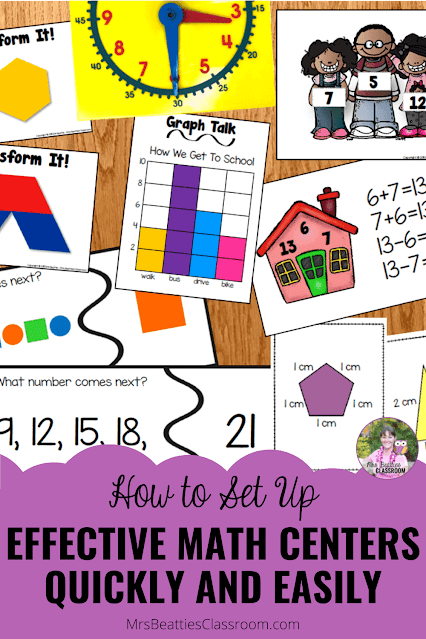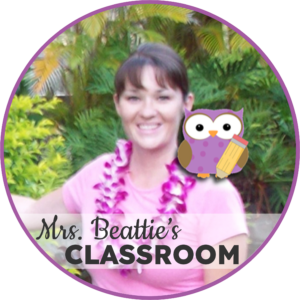Math centers can be a powerful tool in your classroom, but teachers shy away from them because they can be a lot of work to set up. While this is true, there are a few things you can do to set up effective math centers quickly and easily this year!
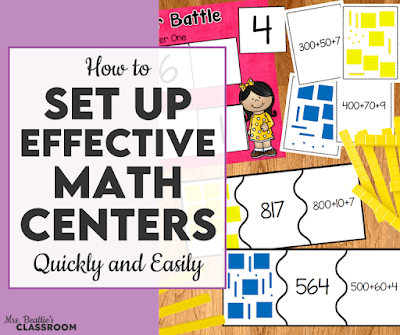
What are the benefits of using math centers?
Using centers in your math classroom has several benefits. First, and most importantly, in my opinion, is the ease with which centers allow you to differentiate for your students. By choosing a quality resource, you can provide students with open-ended activities tailored to the needs of every student in your classroom. This isn’t possible with standard worksheets.
The engagement factor is another great benefit of using math centers in your classroom! When you choose hands-on activities or games, students have fun. Often, they don’t even realize they are learning. In my classroom, our math centers have become the activities my students choose to use when they are finished work or during indoor recess. What a great testament to engagement quality!
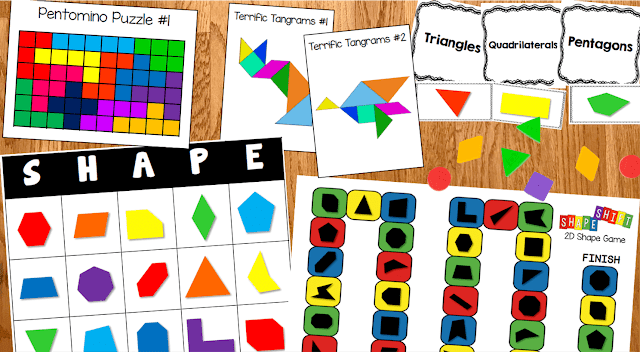
Finally, using centers instead of worksheets allows your students to revisit a concept or skill repeatedly. They’ll complete a worksheet once and be done with it, but if the student is still struggling with the idea, you’ll have to find more worksheets. That takes a lot of time and energy on your part. Having open-ended activities, such as games, students can repeatedly play until they master the skill.
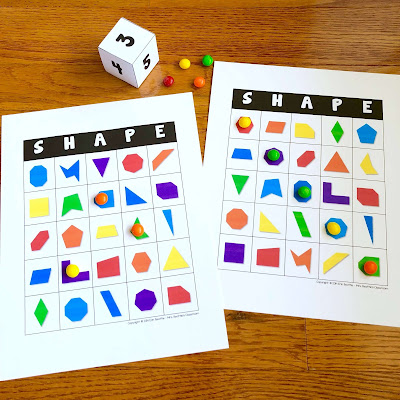
How to Prepare Math Centers
Preparing math centers can take some time initially, but the time you save by assembling them smartly will pay off significantly down the road. I suggest batching the work in the following steps:
- Choose a set or two to begin with and print the student-facing pages. If possible, I recommend using cardstock. The heavier paper will help the pieces stand up to repeated use. I also recommend printing in color if you’re able. Color activities are more appealing and exciting for students. Investigate the HP Instant Ink program and use this link to receive a free month of printing! Printing on colored paper is a good alternative.
- Sort the pages into piles by activity. Ensure nothing is in the wrong place, or you might have trouble sorting it out afterward.
- If possible, laminate the student pieces. Things like games, cards, or printable manipulatives that are part of the center will last longer when laminated, and you won’t have to prep them repeatedly. Also, some student activities may be laminated to use repeatedly instead of photocopying for every student. Consider how you plan to use the activities and determine whether every student must have the page.
- Cut out the pieces and place each activity in a separate plastic zipper bag or envelope. I like to use bags because they generally last longer.
How to Store Math Centers
Storage is the next thing you’ll need to consider. In my years of teaching with centers, I have created a system that has worked beautifully. Each activity within every set of centers is in a separate zipper bag. I keep each topic set of bags in a magazine file box with a label on the front identifying it. My students do not have access to these boxes.
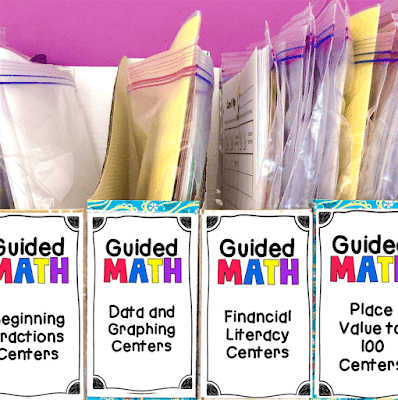
During active rotations, I remove the bags from the magazine file boxes and place them into bins for my students to access independently. Since I use an M.A.T.H. acronym for my math centers, I have one container for each part of my program. My students must use these independently since centers are happening while I teach small groups, so labeling the bins helps with this organization.
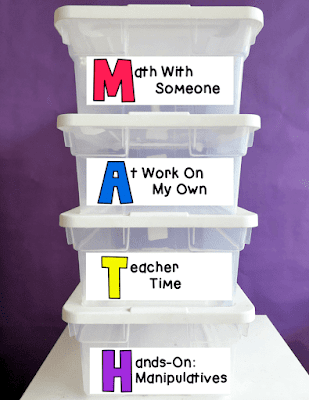
Once these centers are assembled and organized, and if you have high expectations for how students treat the materials, you’ll never have to do this again!
How to Create Math Groups
Teachers always ask me how I create my groups for math centers. There isn’t one correct answer to this question! Even when teaching a split-grade class, my groups remain fluid all year long, and my students quickly understand this to be true and have proven flexible as they move from one group to another. I aim to have groups with students who have similar strengths and needs.
Open Task
One great way to organize your math groups is to give your students an open task at the start of a new unit. As they work, observe to notice attack strategies, strengths, and where your students need support. Use these observations to group students for centers.
Conference
Another excellent way to gauge your students’ abilities is to have a quick one-on-one conference with each of them to have them answer a question or complete a task. These don’t need to be formal conferences and don’t need to take a lot of time.
Previous Performance
Trust your professional judgment! Once you’re a few months into the school year, you’ll know your students better than anyone. It is okay to consider what you know and what you’ve seen your students do in the past and place them into groups based on your professional opinion. If you accept that groups can be fluid and ever-changing, you won’t have issues moving someone from one group to another after the unit and rotations have begun.
Formal Assessment
Of course, you can always use a formal assessment your district provides before creating your groups. Remember that these are often time-consuming and may not be necessary to drive your day-to-day activities. In my Board, we have the Prime Assessment available. Check with your curriculum consultants for more information.
Decide on a System
Now that you have centers ready to go, you need to decide on a system for using them. In a previous blog post, I explained that centers are not your math program. They are part of the program only. You can read more about that here. You’ll need to do some research to decide what will work best for you and your students. Some things to consider are:
- How will your students rotate from center to center?
- What are your expectations for student behavior as they work independently?
- What should students do if they are struggling with an activity?
- How will you handle interruptions?
- What if students need to use the restroom? How do they get your attention?
- How will you collect data on student progress with the skills and concepts in your curriculum?
Rotations
As mentioned, I created a Guided Math program using the M.A.T.H. acronym below.
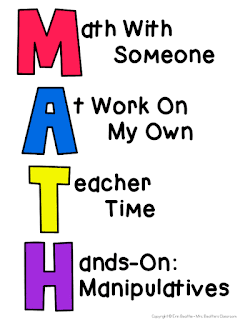
I have centers ready for each of the components except Teacher Time. Four groups rotate through the centers, with one group spending time with me for lessons focused on the group’s needs. The rotations for each day are displayed in a central location, so my students always know what is expected.

Expectations
At the beginning of the school year, we discuss what math center time looks and sounds like. I post these expectations so my students can revisit them as needed.
Struggles
I always have a few students who have a solid grasp of the activities act as helpers. When students work with centers, I teach a small group and do not want to be interrupted. Often, it takes just moments for a peer to explain to a friend how to do something to get them back on track.
I’ve also included a variety of centers in each category of my M.A.T.H. program, so students who are really struggling with one activity can choose another until I can spend some time with them clarifying the task.
Interruptions
In my classroom, we use hand signals for restroom visits. My students can flash the signal at me, and I can agree or decline with a nod or shake of my head without stopping the flow of my lesson.
Assessment and Data Collection
I do not assess the work my students do in centers. These activities are used as practice only. They are designed to be related to the curriculum expectations but open enough to be flexible in their use and accessible to everyone.
I do all of my assessments in my Teacher Time groups. I teach the skills and concepts in the curriculum at each student’s just-right level at this time. I constantly observe and document the skills with which my students work with the lessons and note where the needs for upcoming classes remain.
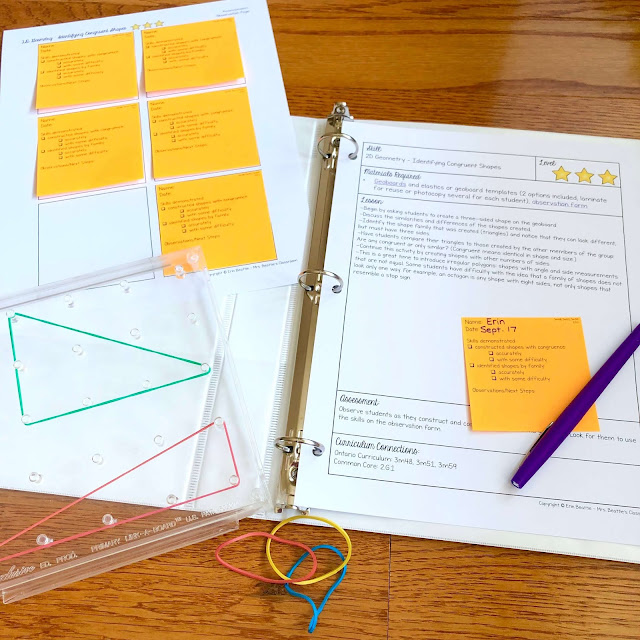
My Differentiated Guided Math Lessons resource contains over 240 lessons covering all parts of the 2020 Ontario Math Curriculum and aligned with the CCSS standards.
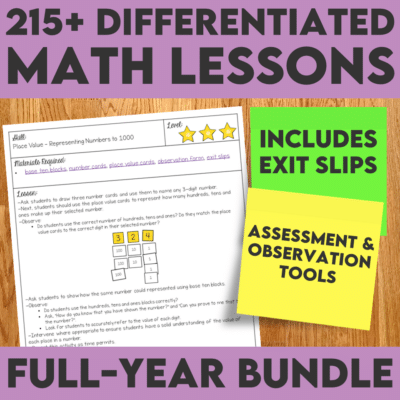
This resource is available in a partially editable format for translation into French right here:
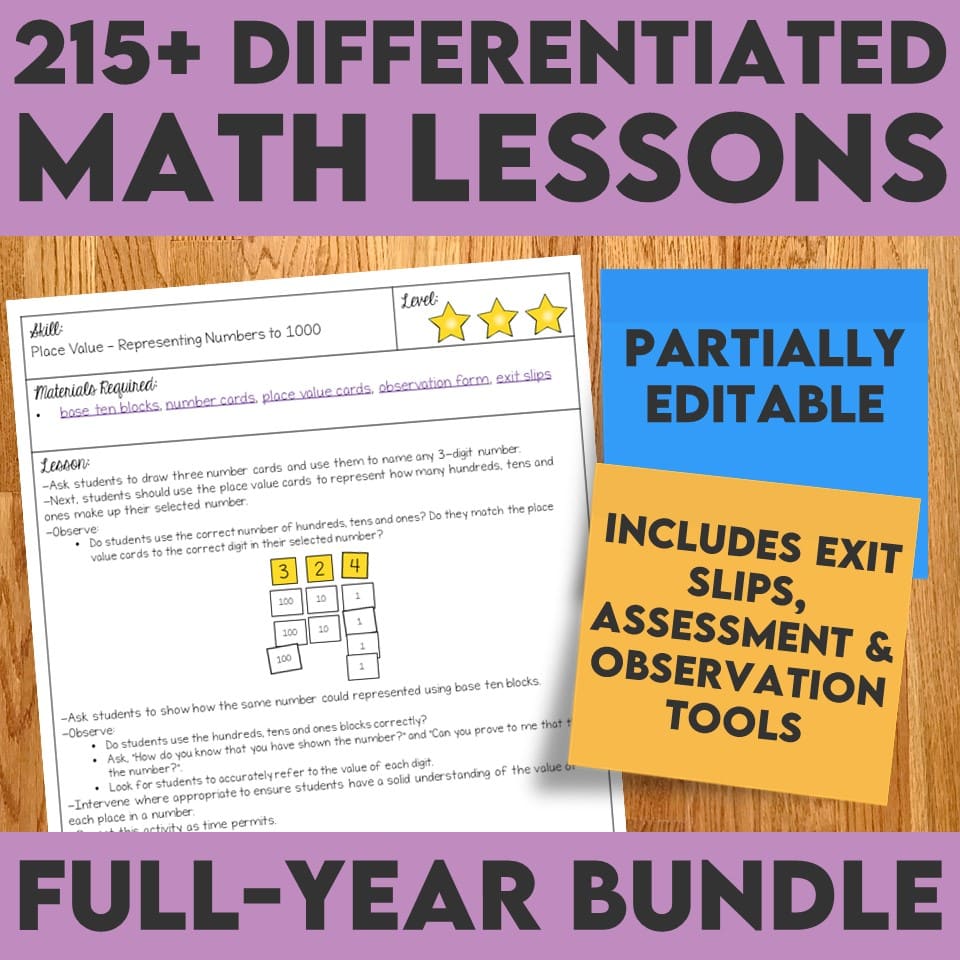
Setting up effective math centers doesn’t have to be a terrible experience when you have systems in place. I have an entire year’s worth of centers available for you. If you’re interested in trying them for free, grab my Guided Math Quick-Start Guide right here:
If you’re ready to get started with centers this year, grab my best-selling Guided Math Centers bundle right here:
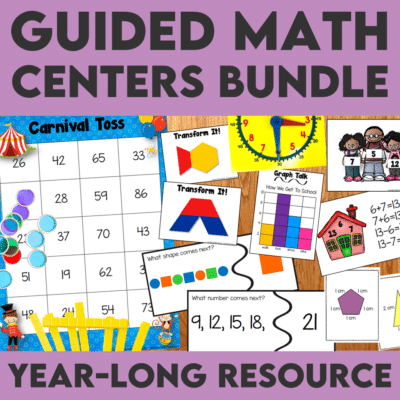
If you have enjoyed this post, please share it with friends and colleagues on Facebook or pin it on Pinterest:
